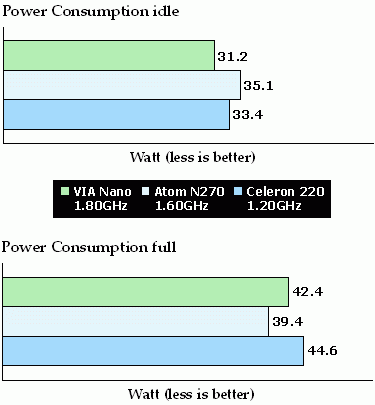Power:
While running an .avi movie and lame at the same time, we measured how much power consumption there is. The Nano board does have quite high peak power consumption which you can't see in the chart, because it is powering down very fast. So, we decided to show you average power consumption. VIA did a good job on idle power, but Atom is better under load. The Celeron board does follow in a close second, but you have to remember, the Celeron is not a very power efficient CPU, consuming 2.5 times as much compared to the Atom.

Conclusion
Atom or Nano are sufficient for everyday use under Windows. Windows installation takes longer compared to a conventional dual-core deskop CPU, but it is not that dramatic. We checked some movies and DVDs, which were not a problem for any of the systems. Trying 720p encoded h.264 turns the situation around. The Nano was not able to play such an H.264 720p content, the Celeron did quite well, mostly with 100% load but smoothly. In this category the Atom is surprisingly the clear winner with about 60% CPU load and hyperthreading helping it to decode properly.
Using such system for surfing, emails, watching non-HD video content is not a problem and this is the sole purpose of such a system. Unfortunately, VIA does not target the mass-markets with its board. Fitted with the strongest of their CPUs they will not attract other masses, too. The fan spins too high, but without the fan it gets too hot. In the industrial sector customers look only for passive solutions to reduce maintenance. Now there is only a single board in the market with a measly 1GHz CPU which runs passive, but quite halving the CPU-power makes it very slow.
Another problem is that such boards will not fit in any ITX cases, because on the back VIA included a mini-PCI and a Compact Flash slot. Of course, there is the biggest argument against it: price. The board retails for €200 and more, which is quite insane. Atom boards are available for about €60, the new Atom 330 dual-core boards are already listed for under €70. So, getting in the mass-market is obviously not VIA's goal. While all-solid designs are now common in the normal desktop market, we wonder why a €200 board is not built in such a way.
As long you don't need all the features VIA provides, you can stay with an Atom board and save lots of money. If you wait six weeks longer, you will get a dual-core Atom which will compensate for its poor performance. Next year Intel should provide an adequate, power-efficent chipset which will make such offers much more attractive.
For VIA it's simple to say: they improved their CPU, but their hype didn't follow suit.
